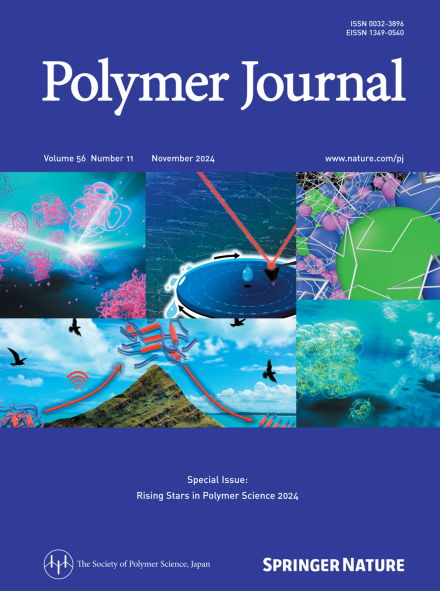Tensegrity-inspired polymer films: progressive bending stiffness through multipolymeric patterning
IF 2.7
4区 化学
Q3 POLYMER SCIENCE
引用次数: 0
Abstract
Materials with J-shaped stress-strain behavior under uniaxial stretching have been developed using various designs; in these materials, the strength increases as the deformation progresses. On the other hand, polymer materials that progressively stiffen under bending are far less explored, and a systematic approach to achieving this behavior has not yet been developed. To address this gap, membrane tensegrity structures, which achieve structural stability by balancing compressive forces in rods and tensile forces in membranes, were examined. Notably, some of these structures exhibit increased stiffness under bending. Using a multipolymer patterning technique, we developed a functional polymer film exhibiting membrane tensegrity-like properties that stiffened under bending. This effect resulted from the membrane tension generated by rod protrusions and a likely increase in the second moment of area at regions with maximum curvature. In this study, the membrane tensegrity concept and multipolymer patterning were used to design functional polymer films that progressively stiffened under bending. This behavior was achieved through the rod protrusions generating tensile forces in the membrane and likely changes in the second moment of the area in the maximum curvature regions. The use of these films can provide a systematic approach to dynamic stiffness under nonuniaxial deformation, enabling applications in soft robotics, adaptive supports, and devices requiring tailored mechanical responses.

受张拉整体启发的聚合物薄膜:通过多聚图案的渐进弯曲刚度
在单轴拉伸下,具有j形应力-应变特性的材料采用了不同的设计;在这些材料中,强度随着变形的进行而增加。另一方面,聚合物材料在弯曲下逐渐变硬的研究还很少,实现这种行为的系统方法还没有开发出来。为了解决这一差距,研究人员对膜张拉整体结构进行了研究,该结构通过平衡杆中的压缩力和膜中的拉伸力来实现结构稳定性。值得注意的是,其中一些结构在弯曲下表现出增加的刚度。利用多聚体图像化技术,我们开发了一种功能性聚合物薄膜,它具有类似膜的张拉整体特性,在弯曲下会变硬。这种效应是由杆突出产生的膜张力和最大曲率区域的第二矩可能增加造成的。在这项研究中,膜张拉整体概念和多聚合物图图学被用于设计在弯曲下逐渐变硬的功能性聚合物薄膜。这种行为是通过杆突在膜中产生张力以及最大曲率区域的第二矩可能发生的变化来实现的。这些薄膜的使用可以为非单轴变形下的动态刚度提供系统的方法,使软机器人、自适应支撑和需要定制机械响应的设备的应用成为可能。
本文章由计算机程序翻译,如有差异,请以英文原文为准。
求助全文
约1分钟内获得全文
求助全文
来源期刊

Polymer Journal
化学-高分子科学
CiteScore
5.60
自引率
7.10%
发文量
131
审稿时长
2.5 months
期刊介绍:
Polymer Journal promotes research from all aspects of polymer science from anywhere in the world and aims to provide an integrated platform for scientific communication that assists the advancement of polymer science and related fields. The journal publishes Original Articles, Notes, Short Communications and Reviews.
Subject areas and topics of particular interest within the journal''s scope include, but are not limited to, those listed below:
Polymer synthesis and reactions
Polymer structures
Physical properties of polymers
Polymer surface and interfaces
Functional polymers
Supramolecular polymers
Self-assembled materials
Biopolymers and bio-related polymer materials
Polymer engineering.
 求助内容:
求助内容: 应助结果提醒方式:
应助结果提醒方式:


